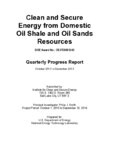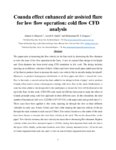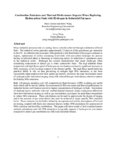TO
| Title | Date | Subject | Description | ||
|---|---|---|---|---|---|
| 151 |
 |
Clean and secure energy from domestic oil shale and oil sands resources: Quarterly progress report: July 2013 to September 2013 | 2013 | Quarterly progress report; July 2013 to September 2013; DE-FE0001243; CO2 management; oxyfiring; CO2 capture; Unconventional fuels; Uinta Basin; Utah; Oil shale; Oil sands; Greenhouse gas control; NER; NEER; GHG; In situ; Ex situ | Disclaimer: "This report was prepared as an account of work sponsored by an agency of the United States Government. Neither the United States Government nor any agency thereof, nor any of their employees, makes any warranty, express or implied, or assumes any legal liability or responsibility for th... |
| 152 |
 |
Clean and secure energy from domestic oil shale and oil sands resources: Quarterly progress report: October 2009 to December 2009 | 2010-02-03 | ICSE; Clean and Secure Energy program; CASE; Itasca Group; Red Leaf Resources; Enshale's; Vernal, Utah; oxy-fuel; CO2 capture; Oil shale; Oil sands; Crude oil; CO2 emissions; International Flame Research Foundation; Pyrolysis; Lattice Boltzmann; Kerogen; Oil recovery simulation; TGA; Dry shale; Pyro... | The Clean and Secure Energy from Domestic Oil Shale and Oil Sands Resources program is part of the research agenda of the Institute for Clean and Secure Energy (ICSE) at the University of Utah. The program was officially launched on October 1, 2009. The project management plan was submitted for revi... |
| 153 |
 |
Clean and secure energy from domestic oil shale and oil sands resources: Quarterly progress report: October 2010 to December 2010 | 2011-01 | ICSE; Oil shale; Oil sands; University of Utah; Marriott Library; Macroscale CO2 analysis; CO2 capture; Flameless oxy-gas process heaters; Liquid fuel production; In-situ thermal processing | The Clean and Secure Energy from Domestic Oil Shale and Oil Sands Resources program is part of the research agenda of the Institute for Clean and Secure Energy (ICSE) at the University of Utah. In this quarter, the Clean and Secure Energy program circulated External Advisory Board recommendations an... |
| 154 |
 |
Clean and secure energy from domestic oil shale and oil sands resources: Quarterly progress report: October 2011 to December 2011 | 2012-01 | ICSE; University of Utah; AMSO; American Shale Oil; Strategic Alliance Reserve; SAR; Utah Division of Oil, Gas, and Mining; DOGM; Large eddy simulation; LES; International Flame Research Foundation; IFRF; Flamelet; Pyrolysis; Kerogen; Thermogravimetric analysis; TGA; CO2 enhanced oil recovery; EOR | The Clean and Secure Energy from Domestic Oil Shale and Oil Sands Resources program is part of the research agenda of the Institute for Clean and Secure Energy (ICSE) at the University of Utah. The Clean and Secure Energy program hosted an External Advisory Board on November 1-2, 2011 and the kickof... |
| 155 |
 |
Clean and secure energy from domestic oil shale and oil sands resources: Quarterly progress report: October 2012 to December 2012 | 2013-01 | ICSE; Oil shale; oil sands; CO2 management; Uinta Basin; Liquid fuel production; In-situ thermal processing; White River oil shale; Green River Formation; American Shale Oil; AMSO; X-ray flourescence; Pyrolysis; Demineralized kerogen | The Clean and Secure Energy from Domestic Oil Shale and Oil Sands Resources program, part of the research agenda of the Institute for Clean and Secure Energy (ICSE) at the University of Utah, is focused on engineering, scientific, and legal research surrounding the development of these resources in ... |
| 156 |
 |
Clean and secure energy from domestic oil shale and oil sands resources: Quarterly progress report: October 2013 to December 2013 | 2014 | ICSE; Quarterly report; Clean and secure energy; Oil shale; Oil sands; Uinta Basin; CO2 management; AMSO; Greenhouse gas control; Shale formation; In situ; Ex situ; TEA-C | EXECUTIVE SUMMARY The Clean and Secure Energy from Domestic Oil Shale and Oil Sands Resources program, part of the research agenda of the Institute for Clean and Secure Energy (ICSE) at the University of Utah, is focused on engineering, scientific, and legal research surrounding the development of t... |
| 157 |
 |
Clean coal program research activities: Final report: Reporting period 07/01/2006-05/31/2009 | 2010-05 | Environment; Emissions; NOx; SOx; Mercury emission; CO2 emissions; Utah Clean Coal Program; Carbon capture and sequestration; CCS; Green field plants; Simulation; Mergury control; Oxycoal combustion; Gasification; Sequestration; Chemical looping combustion; CLC; Materials investigations; NETL; Coal ... | Although remarkable progress has been made in developing technologies for the clean and efficient utilization of coal, the biggest challenge in the utilization of coal is still the protection of the environment. Specifically, electric utilities face increasingly stringent restriction on the emission... |
| 158 |
 |
Clearing the Path | 2018-01 | Student success; University of Utah | A strategic student success agenda. |
| 159 |
 |
Clearn combustion, a path to net zero | Use of fossil fuels as the major source of energy is one of the main sources of GHG emissions that contribute to global warming. However, for at least a foreseeable future, the world will still continue to rely on fossil fuels to sustain the economy and the quality of life. IEA is evaluating the pat... | ||
| 160 |
 |
Clearsign core process burners and boiler burners - burner scaling and field results | 2022 | During previous AFRC Industrial Combustion Symposia, ClearSign Technologies Corporation introduced its ClearSign Core technology currently used in our Ultra Low NOx burner products. These ClearSign Core products have now been developed for different types of equipment applications to meet stringent ... | |
| 161 |
 |
ClearSign eye™: pilot sensor | Clearsign Technologies Corp. has developed and tested a novel, capacitive based flame sensor for use on existing burners in a variety of industrial combustion applications including process burners, boiler burners and flares. ClearSign has developed two probe designs. The first probe design is compa... | ||
| 162 |
 |
Climate change 2007: The physical science basis--summary for policymakers | 2007-02 | Climate change; Greenhouse gases; Aerosols; Solar radiation; Radiative forcing; Third Assessment Report; TAR; Solar activity; Carbon dioxide; CO2; Methane; CH4; Nitrous oxide; N2O; Fossil Fuel; Land use; Agriculture; Land surface properties; Warming; Melting of snow and ice; Rising seal level; Globa... | The Working Group I contribution to the IPCC Fourth Assessment Report describes progress in understanding of the human and natural drivers of climate change1, observed climate change, climate processes and attribution, and estimates of projected future climate change. It builds upon past IPCC assess... |
| 163 |
 |
Closed loop flare control using a video imaging spectral radiometer | Video Imaging Spectral Radiometry (VISR) has emerged as the only practical method to directly and continuously monitor flare performance. The VISR method provides real time measurements of flare combustion efficiency (%) and a smoke index (0-10) at a 1-sec temporal resolution. In addition to these t... | ||
| 164 |
 |
Coanda effect enhanced air assisted flare for low flow operation: cold flow CFD analysis | This paper aims at increasing the flow velocity in the flare stack by decreasing the flow diameter to solve the issue of low flow operation in the flares. A new air assisted flare design of 1m height and 15cm diameter has been tested using CFD simulation in this work. The design includes injecting a... | ||
| 165 |
 |
Colleges, Schools & Divisions | The colleges, schools, and divisions within the University of Utah. | ||
| 166 |
 |
Colorful Gilson did more than promote gilsonite | 1996-03 | The following article from The Times-Independent in Moab pays tribute to the man for whom Gilsonite is named. Utah's American Gilsonite Company traces its roots to Sam Gilson. | |
| 167 |
 |
Combustion emissions and thermal performance impacts when replacing hydrocarbon fuels with hydrogen in industrial furnaces | Many industrial processes rely on heating that is currently achieved through combustion of fossil fuels. The industrial sector generates approximately 23 percent of the greenhouse gas emissions in the US. As infrastructure associated with production and distribution of hydrogen continues to expand, ... | ||
| 168 |
 |
Combustion of municipal solid wastes with oil shale in a circulating fluidized bed | 1996-06-30 | The authors of this report have invented an integrated process for the treatment of municipal solid waste (MSW). In this process, after recycling steps to save usable materials such as aluminum, other metals, and glass have been completed, the resulting refusederived fuel (RDF) is co-combusted with ... | |
| 169 |
 |
Comparing 10 methods for solution verification and linking to model validation | 2005-03-25 | Grid convergence; V&V process; Solution Verification; Discretized continuum; Lawrence Livermore National Laboratory; Computational analyses; Discretization; Continuum process; Finite elemental analyses | Grid convergence is often assumed as a given during computational analyses involving discretization of an assumed continuum process. In practical use of finite difference and finite element analyses, perfect grid convergence is rarely achieved or assured, and this fact must be addressed to make stat... |
| 170 |
 |
Comparison of kinetic analysis of source rocks and kerogen concentrates | 1994-05-10 | Shales and kerogen concentrates from the Green River, Rundel, Ohio, Kimmeridge, and Phosphoria formations were examined by Pyromat II micropyrolysis and kinetic parameters were determined by the shift-in-Tm a x , discrete distribution, modified Friedman, and modified Coats-Redfern methods. Overall, ... | |
| 171 |
 |
Comparison of laboratory and field steamfloods in tar sand | In situ recovery technologies for tar sand and heavy oil are simulated at the Western Research Institute to prepare for pilot tests and commercial operations. Wide ranges of process parameters are tested in one-dimensional reactor tubes in which the tar sand or heavy oil is uniformly reconstituted t... | ||
| 172 |
 |
Comparison of methods for measuring kerogen pyrolysis rates and fitting kinetic parameters | 1987-03-23 | We determine rates of product evolution during pyrolysis of several petroleum source rocks and isolated kerogens by nonisothermal techniques, including Rock Eval pyrolysis and pyrolysis-MS/MS. The resulting data are analyzed by nonlinear regression and simpler correlation techniques in terms of disc... | |
| 173 |
 |
Composition and origin of the Uinta Basin bitumens | 1963-01 | The names of the three formations of interest, from oldest to youngest, the Wasatch, Green River, and Uinta, have been used largely as facies terms to differentiate sediments which were believed to be of different age but actually were deposited simultaneously. The Wasatch is predominantly fluviatil... | |
| 174 |
 |
Computational study of the anode baking industrial furnace | Turbulent flow; Eddy dissipation model; Combustion, NOx; Zeldovich mechanism | In the aluminium industry, the Hall-Héroult process is used for smelting of aluminium using carbon electrodes such as anodes. The baking process of anodes is required for their maximum efficiency during this electrolysis process. The anode baking process contributes up to 15% costs in the aluminium... | |
| 175 |
 |
Concentration of eastern oil shales by froth flotation | 1983 | Concentration of Eastern oil shale has been accomplished by size reduction and froth flotation techniques. The efficiency of kerogen recovery depends on the extent of size reduction (1iberation) as well as frother and promoter additions. Certain grinding aids sucli as sodium silicate and fuel oil ha... |
